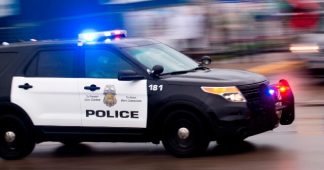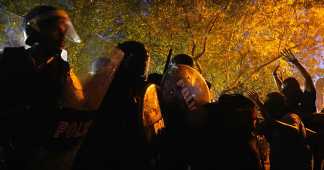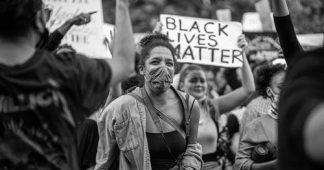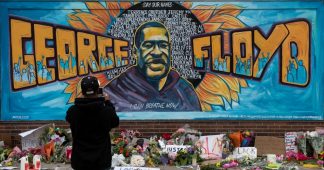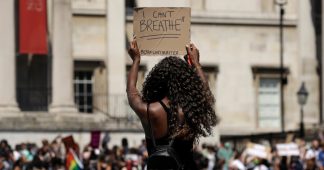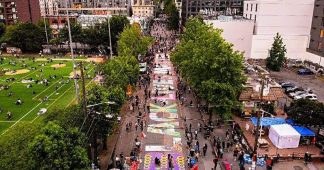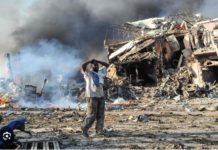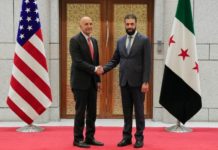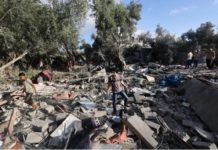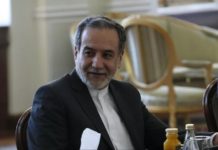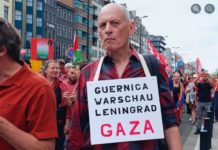October 8, 2020
Photo by Nathaniel St. Clair
Following the killing of George Floyd, Pres. Donald Trump issued a tweet that expressed his anger at the protestors:
“I can’t stand back & watch this happen to a great American City, Minneapolis. A total lack of leadership. Either the very weak Radical Left Mayor, Jacob Frey, get his act together and bring the City under control, or I will send in the National Guard & get the job done right.”
A few hours later, he ranted on:
“These THUGS are dishonoring the memory of George Floyd, and I won’t let that happen. Just spoke to Governor Tim Walz and told him that the Military is with him all the way. Any difficulty and we will assume control but, when the looting starts, the shooting starts. Thank you!”
Trump’s warning – “when the looting starts, the shooting starts” – has been his and his administration’s approach to the nation-wide wave of popular protest ever since. It has been the rationale by which Trump could blame protesters for the civil unrest and overlook the role played by infiltrators in promoting violence and looting.
Reports of agents provocateurs, outside agitators and police infiltration of protests are appearing throughout the country and involving law-enforcement agents and rightwing nationalists. The most public role of such a disruptor was detailed in Minneapolis at the time of Trump’s provocative tweets and involved someone who has come to be known as the “Umbrella Man.”
On May 27th, two days after Floyd’s killing, a video caught a man walking in front of an AutoZone shop at E. Lake Street and Minnehaha systematically breaking the store’s windows. He is dressed in black and wares a face-covering gas mask; in one hand, he carries a sledgehammer and, in the other, an umbrella although it is not raining. Local police later reported that the man had spray-painted “free [expletive] for everyone zone” on the store’s double front doors. Protestors follow the man and keep asking him to stop but to no avail.
The police noted that the AutoZone shop was among dozens of buildings across the city that burned to the ground in the days that followed. “This was the first fire that set off a string of fires and looting throughout the precinct and the rest of the city,” Sgt. Erika Christensen wrote in a search warrant. “Until the actions of the person your affiant has been calling ‘Umbrella Man,’ the protests had been relatively peaceful. The actions of this person created an atmosphere of hostility and tension. Your affiant believes that this individual’s sole aim was to incite violence.”
Rumors circulated that the provocateur was an undercover St. Paul police officer seeking to incite violence. However, the Minneapolis Police Dept. received an email tip identifying the “Umbrella Man” as a member of the Hells Angels biker gang who “wanted to sow discord and racial unrest by breaking out the windows and writing what he did on the double red doors.” Sgt. Christensen reported that the provocateur had a criminal history that included convictions of domestic violence and assault.
As reported in the Star Tribune, “the president of the Hells Angels summoned 75 members of the Aryan Cowboy Brotherhood to the help protect the club’s headquarters in north Minneapolis, according to an intelligence memo, which surfaced in June as part of a massive trove of leaked law enforcement documents dubbed ‘Blue Leaks.’”
A club member later posted a warning to protesters on Facebook saying that while the Angels agreed with the anti-law enforcement message, any protests that reached the clubhouse or “any of our neighborhoods” would be “met with a very unfriendly welcome party.”
Compounding this situation was Trump warning to Minnesota’s Gov. Tim Walz:“Any difficulty and we will assume control …” Trump failed to mention that Minnesota was hit by a cyberattack as law enforcement attempted to contain the protests in Minneapolis and St. Paul. “Before our operation kicked off last night, a very sophisticated denial of service attack on all computers was executed,” Walz said. “That’s not somebody sitting in their basement. That’s pretty sophisticated.” This was a second front in political provocation.
***
The episode in Minneapolis involving the “Umbrella Man” is the most detailed account of the role of an agent provocateur in furthering violence and looting amidst a pollical protest. However, numerous other reports of outside agitators have appeared at demonstrations throughout the country. Unfortunately, these reports lack both the detail (e.g., video, witness observation) and police/law enforcement confirmation. Nevertheless, these anecdotes suggest the range of suspected actions being undertaken and the actors involved to destabilized legitimate protest.
A sampling of possible actions by agent provocateur follows.
Philadelphia, PA – in early June numerous reports circulated that peaceful protests across the state were being infiltrated by white supremacists and other extremists. “I’ve been on the ground for three days in Philadelphia, and I’m disturbed by what I’m seeing,” said Chad Dion Lassiter, a national expert on race relations and the executive director of the Pennsylvania Human Rights Commission. “What I saw was a coordinated effort of looting encouraged by white supremacists who hide behind signs demanding justice while promoting anarchy,” Lassiter said.
Lancaster, PA — Police Chief Jarrad Berkihiser said police have “definite evidence” that white nationalists were among the crowds of protesters during the previous weekend. They were wearing body armor and carrying handguns, and “caucasian individuals” threw rocks and bottles containing cayenne pepper at police. He added, there were also threats to set fire to the police station, the county courthouse and local stores.
Fargo, ND – following George Floyd’s killing on June 4th, a rogue assistant police chief was accused of creating “danger for himself and any officer who may have needed to come to his aid” at a Black Lives Matter (BLM), yelled “F**k the police” while checking for guns at a Black Lives Matter protest; the officer resigned.
El Paso, TX – on June 4th, the Texas Department of Public Safety reported, “There’s violent extremists, there’s anarchists, there’s Antifa. But there’s also criminals that are using this as an opportunity to exploit to loot and to hurt others. That’s happened.”
DPS’ Steve McCraw said law enforcement is embedding undercover agents to try to catch infiltrators and arrest them to try to keep protesters safe and let protesters exercise their Constitutional right to demonstrate.
“We do have special agents embedded trying to identify criminals that are leveraging, or are using this as an opportunity, exploiting these demonstrations,” added McCraw.
Kansas City, KS – on June 16, rightwing Boogaloo provocateurs and nationalist showed up at a BLM rally and were rumored to have been behind the burning of a Kansas City police car.
Richmond, VA – on June 28th, Mayor Levar Stoney declared, “There were white supremacists marching under the banner of Black Lives Matter, attempting to undermine an otherwise overwhelmingly peaceful movement towards social justice.”
Austin, TX — a car was driving into a crowd of protestors at a demonstration on July 2nd and the driver was asked not to “do that you’re going to get somebody hurt.” The driver then rolled down his window, pointed his rifle at the man, and fired three shots at close range. The victim was taken to a local hospital with “life-threatening” injuries and died; the police later reported the incident was deemed a homicide. Failing to escape, the driver was detained but neither the shooter’s name nor the name of the victim has been revealed.
Portland, OR – on July 29th, John K. Olson, U. S. Bankruptcy Judge (retired) posted the following statement: “It appears likely that at least some of the asserted violence and anarchy is in fact instigated by agents provocateurs funded by our own secret police.”
Writing in The Atlantic, David Graham made the following observation:
“An outside agitator is stirring up violent protest in the streets of Portland, Oregon. His hand is at work in Seattle; Oakland, California; and Los Angeles, too. This agent provocateur set out to inflame protests simmering in these cities by making sure that armed hordes were in their midst, and it has worked: Many more protesters are out on the streets, throwing bricks at law-enforcement officers and engaging in vandalism. Blocks of these cities have been engulfed in tear gas. Mayors are pleading for calm.”
He concluded, “The outside agitator’s name is Donald Trump, and he lives at 1600 Pennsylvania Avenue in Washington, D.C.”
***
The FBI launched the Counter Intelligence Program – COINTELPRO – in 1956 and it remained in effect until 1971 in the face of a threat of public exposure. In 1975, U.S. Senate established the Church Committee to investigate abuses by the Central Intelligence Agency, National Security Agency, Federal Bureau of Investigation and the Internal Revenue Service. It noted:
“… the Bureau went beyond the collection of intelligence to secret action designed to “disrupt” and “neutralize” target groups and individuals. … Many of the techniques used would be intolerable in a democratic society even if all of the targets had been involved in violent activity … The unexpressed major premise of the programs was that a law enforcement agency has the duty to do whatever is necessary to combat perceived threats to the existing social and political order.”
In June 2020, in the wake of the growing protests against police killings of Black people, the Intercept published a disturbing study of law-enforcement agents provocateurs infiltrating popular protests as part of COINTELPRO. Its scarry to recall how extensive FBI infiltration was of the Klan, anti-Vietnam War protestors and the Black Panther Party. A handful of these actions are identified – sadly, many more are not included.
+Gary Thomas Rowe infiltrated the Ku Klux Klan in 1960 and provided the FBI with a warning that the Klan was planning attacks on Freedom Riders arriving in Alabama from the north.
+ William O’Neil was the informant who gave the FBI the detailed floor plan of Fred Hampton’s apartment that facilitated the Chicago police assault and the murders of Hampton and Mark Clark, Black Panther Party leaders, in 1969.
+ In May 1970, an informant working for both the Tuscaloosa police and the FBI burned down a building at the University of Alabama during protests over the recent Kent State University shootings.
+ An FBI informant in the Weather Underground took part in the bombing of a Cincinnati public school.
+ An FBI informant operating within a chapter of the Vietnam Veterans Against the War promoted “shooting and bombing” that lead to a bombing and a bomb threat.
+ An FBI informant in Seattle drove a young black man named Larry Ward to a real estate office that engaged in housing discrimination and encouraged him to place a bomb there; the police were waiting and killed Ward.
+ An FBI informant in New York provided 13 Black Panthers 60 sticks of dynamite to use in a plot to blow up the Statue of Liberty.
+ After 28 people broke into a federal building to destroy draft files in 1971, an FBI informant bragged, “I taught them everything they knew.” All 28 were acquitted when his role was revealed.
And then there is “Tommy the Traveler” – aka Momluang Singkata Thomas Tongyai N’Ayudhya whose father was from Thailand – who worked undercover for the FBI, keeping “his eye on radical movements,” until at least the spring of 1970, when he was deputized by the Ontario County (NY) Sheriff’s Office, “strictly as an undercover man and what we call a ‘narco’—narcotics officer …” He apparently also sold his services to the Buffalo FBI field office.
In ‘70s, “Tommy” organized an attack on the Reserve Officer Training Corps (ROTC) office at Hobart College (Geneva, NY), that involved breaking windows and bringing ROTC files outside and burning them or throwing them into the lake. He also appears to have persuaded a couple of anti-war freshmen to toss a Molotov cocktail into the ROTC office in the basement of a dorm with students sleeping above.
“Tommy” is the subject of Marc Weiss 1971 documentary, “The Revolutionary Was A Cop.” He said that the “best cover for an undercover agent who wanted to get on to the campus was portraying the part of a radical extremist, which I did. That way you are so far from what they would expect a law enforcement officer to be, you can pretty well get in and start moving around.”
In the wake of the Church Committee revelations there was an apparent hiatus in the FBI’s and local police active use of agents provocateurs and informants. However, the game changed in the wake of the 9/11 attacks. According to one report, the FBI “encouraging violent acts” that led to the indictment of 150 people in various sting operations.
The FBI and local law enforcement undertook subversive and provocative actions in the wake of the Occupy movement. In October 2013, New York police arrested Wojciech Braszczok, 32, a cop, with gang assault, assault and criminal mischief in connection with an attack on SUV driver. Braszczok was known within the Occupy Wall Street movement as “Al.” He apparently showed up at Occupy parties and was “arrested” at a protest. As the Gothamist notes, “It’s unclear whether that was a bogus move to strengthen his cover.
The FBI targeted Occupy activists in Cleveland. In 2012, working with an informant, it created a plot to blow up a bridge in Cleveland, seducing five Occupy activists into it.
In Chicago, two police field intelligence agents — Mo and Nadia — infiltrated the local Occupy group. The two agents were on a 90-day undercover assignment to attend Occupy events and – as reported in The Guardian – “ultimately entrapped three members of Occupy, known as the NATO 3, Brent Betterly, Jared Chase, and Brian Church, who were arrested in May of 2012 and charged with conspiracy to commit terrorism during the NATO Summit protests.”
Agents provocateurs, outside agitators and police infiltrators play an important role in how law enforcement offices – be they federal or local – turn legitimate protests into civil disturbances, often involving “terrorist” acts. So, be suspicious of those who express the most “radical” actions at a demonstration or popular mobilization as it might be a calculated action to delegitimize the protest.
Published at https://www.counterpunch.org/2020/10/08/protests-provocateurs-infiltrators-are-disrupting-blm-protests/
